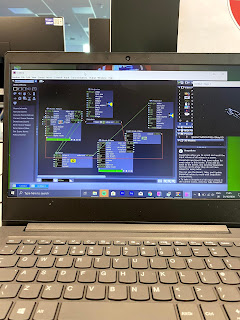Interactivity
Interactivity:
Interactivity is a way of telling a story digitally, in which the audience can determine the outcome of the narrative. The audience can choose certain options for their own viewership needs and pleasure. This is applied to any media platform that allows the user to generate their desired result.
Interactivity first occurred in the mid 1960s. ELIZA, which is a natural language processing software, created by Joseph Weizenbaum allowed users to speak to their computer. This was the first development of interactivity between humans and media as it allowed the audience to ask question or just have a conversation with the computer, just by typing in what they want to say. Eliza, known as the first 'chatterbot', was designed based off of therapy. Programmed to answer any of the users wants and needs. It had flaws as it could respond to what was being asked, but not gain a true understanding of a situation completely.
From these early developments of Eliza, to present day with the development of Artificial Intelligence (AI). There are ones attached to your mobile phones like Siri. Siri came out in 2011 and it allows you to ask it a question and it will give you the correct answer most the time. Such as a calculation, spelling or the weather today. However, it has its same flaws as you struggle to have a conversation with it but its purpose to find information for you without typing.
These are programmed robots that can replicate humans' movement, expression, conversation and intelligence. An example is 'Sophia' one of many humanoid robots created in 2016, in Hong Kong by Hanson Robotics. Sophia is more sophisticated and human like than Eliza due to development in technology from the 1960s to the 21st century. Sophia can be seen physically rather than through a screen, is capable of moving and can teach herself new things without software interference. Sophia was made as a consequence of Eliza. It is known as the 'Eliza effect' - the fear of a computer becoming too human like. Many people fear the technology as they believe the humanoids will become superior to humans in intelligence and take-over the world.
The first interactive fiction text game (Colossal Cave Adventure) was created in 1977 by William Crowther. The concept of the game is the player types in one or two word text commands direct the player around a cave. If you type in the correct command you discover treasure along the way. However, if you do not you will die. The aim is to collect all the treasure without dying.

Again, this has been further developed to modern day. There are many interactive video games that have been produced stemming from Colossal Cave Adventure. One is The Walking Dead (2012). The walking dead is you following round a character in third person attempting to survive a zombie apocalypse. This allows the user to determine the outcome of what they want to see happen on their screen. You are given a time limit and three options to choose from. Whichever one you chose will happen. It takes the narrative in a different direction for each individual user, depending on the user's choice. It is called a 'conversation tree' by the producers. For example, if person one chose option A and person two chose option B, their interactive story will differ. This is a continuous cycle throughout the game as the users, will unravel their desired story. An example below, is a tree that would show how each scene differs depending on choice of the user. This was a huge success leading to many sequels of the game and inspiring others.
Task:
Our task was to use the software isadora and experiment what we could create with it.
Isadora is a graphic software programme which allows you to add effects on to videos. It is interactive as it uses the same layout as other interactive media, through a tree diagram layout with one box effecting another one as a consequence.
Idea:
The idea we has to try and manipulate the video to the best of our ability. We did this by adding a spinning effect, a timer as well as moving onto another clip after.
Final Product:
Reflection:
I was intrigued when learning about interactivity and liked the idea of making something to do with interactivity. However, using the isadora software was really difficult. I struggled with great degree to get my head around it and felt very limited in creation. Therefore, I want be making my final artefact on it as I feel restricted in trying to use the software to its full capabilities.

Comments
Post a Comment